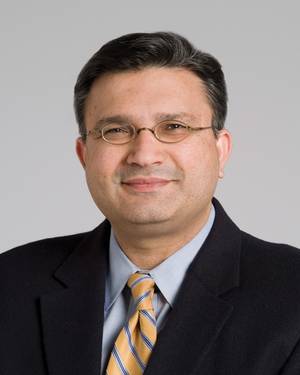ORLANDO – Prolonged thromboprophylaxis with 30 days of oral apixaban in initially hospitalized, acutely medically ill patients proved no more effective and caused more major bleeding than 6-14 days of enoxaparin in a major randomized clinical trial.
Results of the 6,528-patient Apixaban Dosing to Optimize Protection from Thrombosis (ADOPT) trial provided no support in the medically ill for the sort of multiweek extended prophylaxis against venous thromboembolism (VTE) that’s routine in patients undergoing total hip replacement or other high-risk orthopedic surgery. But the ADOPT trial is very unlikely to be the final word on this issue, according to lead investigator Dr. Samuel Z. Goldhaber, who presented the study findings in a late-breaking trials session Nov. 13 at the annual scientific sessions of the American Heart Association.
Observers agreed with this assessment. They commented that the 13% relative risk reduction in VTE-related events seen in the apixaban group, while falling short of statistical significance, was actually encouraging in light of a couple of study design problems that stacked the deck against the investigational oral direct factor Xa inhibitor. They predicted that better-designed studies of extended thromboprophylaxis with apixaban or the other new oral anticoagulants are likely to be in store.
ADOPT was a double-blind, placebo-controlled trial conducted at 302 centers in 35 countries. It involved restricted-mobility patients hospitalized for medical conditions placing them at increased VTE risk, including heart failure, respiratory failure, cancer, acute rheumatic disorders, infection, and inflammatory bowel disease. Participants were randomized to oral apixaban at 2.5 mg twice daily for 30 days or subcutaneous enoxaparin at 40 mg once daily for 6-14 days followed by placebo.
The primary efficacy end point was the 30-day composite of death related to VTE, fatal or nonfatal pulmonary embolism, symptomatic deep vein thrombosis, or asymptomatic proximal-leg deep vein thrombosis. This composite end point occurred in 2.71% of the apixaban group, compared with 3.06% in the enoxaparin arm, a 13% relative risk reduction.
The 30-day major bleeding rate was 0.47% in the apixaban group and 0.19% with enoxaparin. The resulting 2.58-fold increased relative risk of major bleeding in the apixaban group was significant.
"Apixaban is, in my mind, still a very attractive agent for the prevention of venous thrombosis."
A major study limitation was that one-third of the 6,528 participants couldn’t be evaluated for the primary efficacy end point, because they lacked a follow-up systematic bilateral compression ultrasound exam of the legs. As a result, the study was underpowered, and the 13% relative risk reduction didn’t achieve statistical significance.
The purpose of the follow-up ultrasound was to detect asymptomatic proximal-leg deep vein thrombosis. The Food and Drug Administration required that this be part of the primary efficacy end point, even though compression ultrasonography after hospital discharge isn’t routine practice and the clinical significance of asymptomatic VTEs remains unclear.
The other major problem with the ADOPT design was that the comparison arm didn’t reflect real-world clinical practice, which is to stop enoxaparin prophylaxis at the time medically ill patients are discharged. This is done because many frail, sick patients find self-injection of enoxaparin too daunting. In ADOPT, the average length of stay was 5 days, but patients in the enoxaparin arm were on the low-molecular-weight heparin for 6-14 days, again as requested by the FDA.
Dr. Goldhaber,a cardiologist at of Brigham and Women’s Hospital in Boston, noted that as soon as enoxaparin prophylaxis stopped, the rate of VTE events in that study arm took a 45-degree upturn. As a result, a key secondary study end point – the rate of symptomatic VTE or VTE-related death after parenteral enoxaparin was stopped – occurred in 0.56% of the enoxaparin arm compared with 0.25% in the apixaban arm. This difference represented a 56% relative risk reduction favoring apixaban, which just missed attaining significance. This finding suggests that a strategy of extending thromboprophylaxis for longer than 6-14 days shows considerable promise.
"I think ADOPT’s gift to the medical community is to point the way toward a future trial that does not require ultrasound unless the patient is symptomatic and in which the comparison group allows VTE prophylaxis as it is really practiced – giving it in the hospital and not post discharge as in ADOPT," he said.
Dr. Elliott Antman, chair of the scientific sessions program committee, predicted in an interview that such trials are likely to occur, given that pulmonary embolism causes at least 150,000 deaths per year in the United States alone.
"This is an important medical problem that needs to be adequately treated, and I don’t think we’re doing a good enough job now. I think if future trials restrict the end point to symptomatic venous thrombosis and the duration of treatment in the comparator arm is kept to the way we do it now, then we may see some real benefit for a drug like apixaban. Apixaban is, in my mind, still a very attractive agent for the prevention of venous thrombosis. We just need to learn how to design a trial to demonstrate what I think is the true benefit of these new oral anticoagulants," said Dr. Antman, professor of medicine at Harvard Medical School, Boston.


